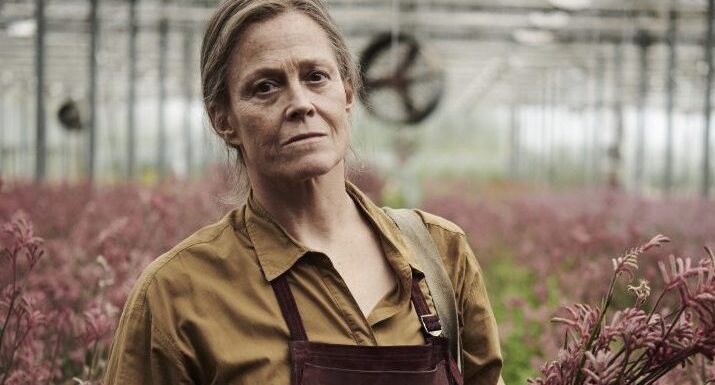
In “The Lost Flowers of Alice Hart,” the namesake plants have multiple meanings. After a fire takes the lives of both of her parents in coastal Australia, nine-year-old Alice (Alyla Browne) moves to Thornfield, a secluded wildflower farm run by her estranged grandmother June (Sigourney Weaver). But Thornfield is more than just a source a native flora; “flowers” are also what June calls her employees, all women escaping violent pasts and troubled home lives. That group now includes Alice, whose father Clem (Charlie Vickers) — June’s son — physically abused both her and her mother Agnes (Tilda Cobham-Hervey), who was pregnant at the time of her death. Rather than discuss this painful irony, June and Alice rely on floriography, the traditional art of using flowers as symbols imbued with specific meaning. In this coded language, an artfully curated bouquet can stand in for a frank conversation.
Adapted from Holly Ringland’s novel of the same name, “The Lost Flowers of Alice Hart” packs a great deal — too much, perhaps — into a single concept. Just as flowers can be plants, people or an entire language unto themselves, the limited series from Amazon Prime Video overcrowds its seven episodes with subplots and twists that obscure its deeper resonance. Combined with an awkward pace that lingers far too long on some story beats while skipping over others entirely, the effect is counterproductive. “The Lost Flowers of Alice Hart” wants to shed light on the lived experience of gendered abuse, and in that attempt, showrunner Sarah Lambert and director Glendyn Ivin employ some powerful imagery and performances. But the show too often heightens itself into melodrama, the opposite of the realism and sensitivity called for by its subject matter.
Before the fire, Alice is an avid reader who earns the affection of Sally (Asher Keddie), a local librarian mourning the loss of her own daughter at around Alice’s age. This dynamic is moving enough on its own, but “The Lost Flowers of Alice Hart” heaps on a series of unnecessary revelations about Sally’s romantic past and relationship with Alice’s parents, some of which come out of left field and with no basis in what we see onscreen. Similarly, the show spends several episodes on Alice’s adjustment to Thornfield, then flashes forward to her life as an adult. In between, we learn Alice had a romance with a childhood friend, a formative bond we only watch unfold in flashback. That Alice’s first love is an undocumented immigrant is both abruptly announced and only used to set up the couple’s tragic split. The lead-up to and immediate aftermath of the Hart fire start to drag, while key moments in Alice’s life lack room to breathe — or bloom, if we’re sticking to the flower metaphor.
Such structural issues undermine the material that’s meant to be the crux of the show. After a fight with June, Alice leaves home and gets a job as a ranger at a national park with natural beauty Ivin captures in all its grandeur. There, Alice meets Dylan (Sebastián Zurita), a colleague who starts to resemble her father in disturbing ways as they fall in love. But while the cyclical nature of abuse is a worthwhile theme, it requires time to illustrate with subtlety and without resorting to caricature. Like many aspects of “The Lost Flowers of Alice Hart,” Alice and Dylan’s courtship could be an entire show, but it’s crammed into half of one.
As with many adaptations, the series is too literal a translation of its source, lacking the adjustment required to fit its new medium. The result makes for an informative contrast with “Big Little Lies,” another Australian book-turned-limited-series that hinges on a portrait of intimate partner violence. (The two shows also share an executive producer in Bruna Papandrea.) The HBO show focused on a single abusive dynamic, presenting the audience with a seemingly idyllic marriage before gradually going behind closed doors. It also depicted the protagonist’s plight with sudden, quick cutaways that mimicked the intrusion of traumatic memory. Editorially and aesthetically, these choices helped “Big Little Lies” fit its story to its format — far more so than packing as much plot as possible into monologues, as “The Lost Flowers of Alice Hart” does.
Despite its flawed approach, there are moments when “The Lost Flowers of Alice Hart” gets out of its own way. As June, Weaver gives steely resolve to a woman whose fierce desire to protect her loved ones, rooted in traumas of her own, ends up driving them away. (Weaver also does some great accent work; she may be used to Oceania after all that time spent shooting “Avatar” in New Zealand.) June’s partner Twig (Leah Purcell) is Indigenous, with a backstory that illuminates how sexism can interact with state-sanctioned racism that tears families apart. Twig’s arc is both specific to Australia and resonant for American viewers who can trace its analogs in our own history.
But the structure of “The Lost Flowers of Alice Hart” just isn’t built to serve its strongest elements. At once both rushed and distended, the show takes an all-too-real issue — or rather, set of interrelated issues — and renders them so operatically as to read artificial. By the series’ end, its characters have endured rape, incest, gay-bashing, battery and the loss of their children, a cavalcade of misery that blurs together over time. Flowers are delicate things; “The Lost Flowers of Alice Hart” is too blunt to take care with them.
The first three episodes of “The Lost Flowers of Alice Hart” are now streaming on Amazon Prime Video, with remaining episodes airing weekly on Fridays.
Read More About:
Source: Read Full Article